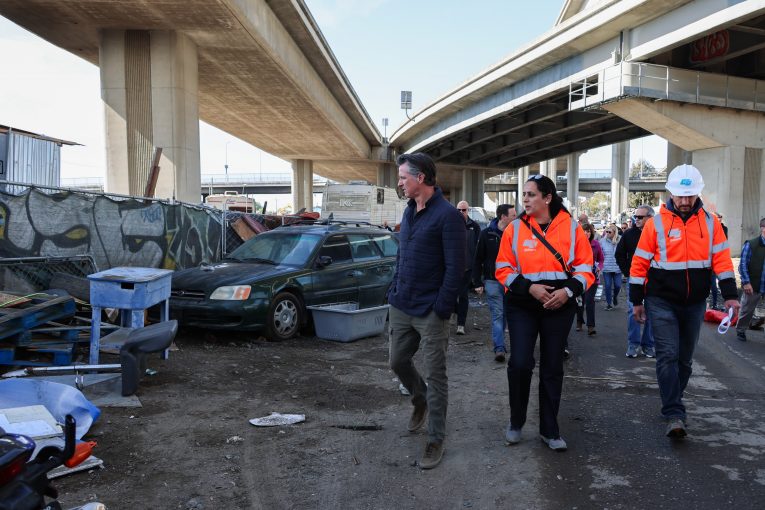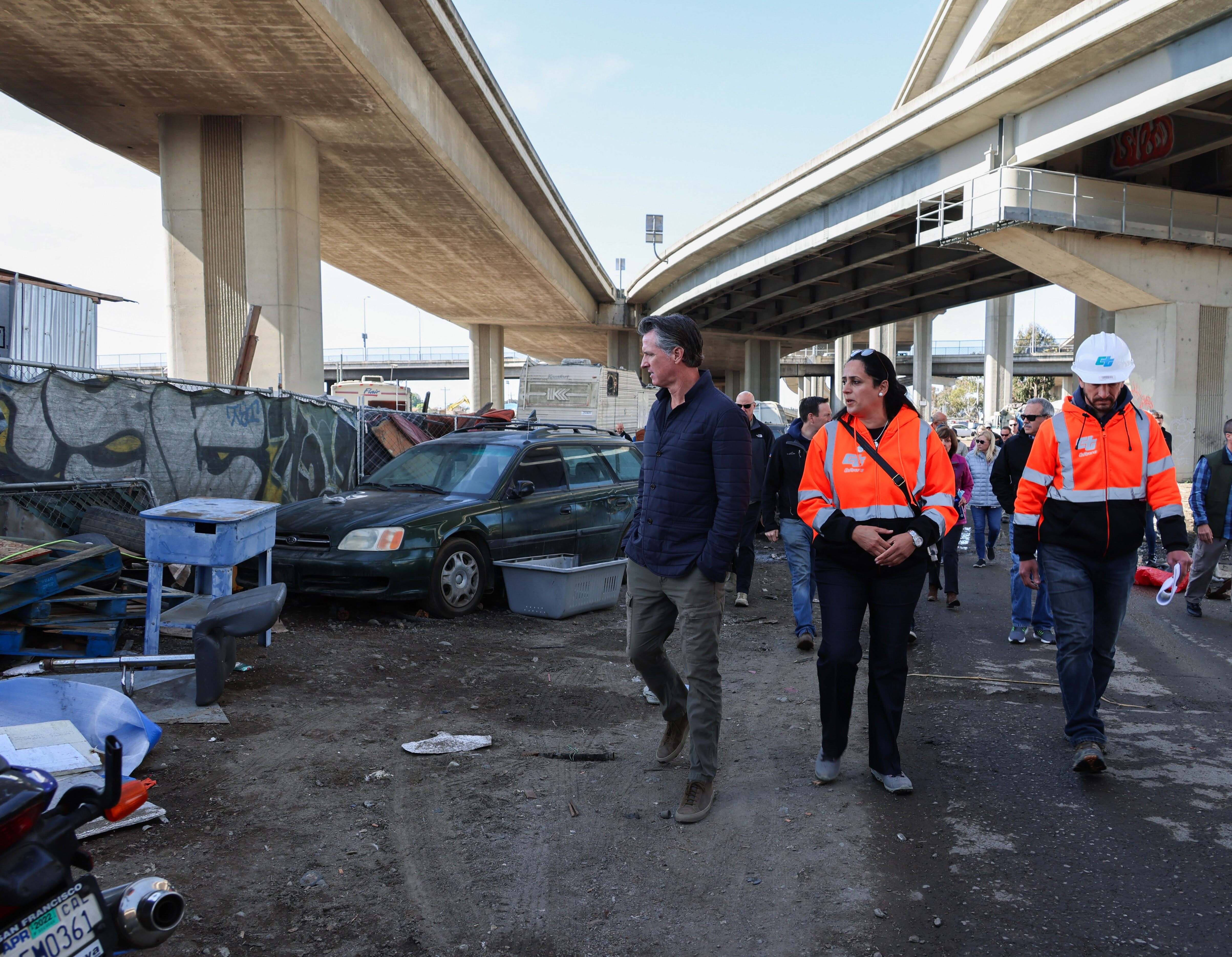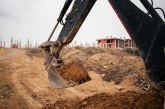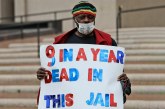
 By Vanguard Staff
By Vanguard Staff
Oakland, CA – The governor on Friday took his cabinet members to visit an encampment in Oakland to discuss the inhumane living conditions too many Californians face.
“Since his first day in office, the Governor has made addressing homelessness a top priority for the administration,” a release noted.
Governor Newsom’s multibillion-dollar plan to tackle homelessness is “an all-government effort to rapidly provide housing and connections to behavioral and physical health supportive services to individuals experiencing homelessness, while also cleaning up the state’s highway off-ramps and encampments.”
“Encampments across our state are constant reminders of the broken dreams of struggling Californians and their loved ones, making them a stubborn, painful issue that we must tackle with empathy,” said Governor Newsom. “Homelessness affects us all and California is taking an all-hands approach to tackle this challenge from every angle.”
PPIC recently conducted a survey finding that that the overall share of Californians who say homelessness is a big problem in their part of the state is nearly two-thirds (64%), similar to the share who held this view before the start of the pandemic.
There is agreement across partisan groups that homelessness is a big problem (68% Democrats, 64% Republicans, 68% independents).
According to a report by the US Department of Housing and Urban Development, California’s homeless population increased 7% from 2020 to 2021.
The governor and his cabinet members walked the Oakland encampment and spoke directly with people experiencing homelessness. The visit was followed by a cabinet meeting to discuss the strategies all state agencies can employ to tackle the homelessness crisis.
Governor Newsom’s multibillion-dollar homeless housing investments will provide more than 55,000 new housing units and treatment slots in the coming years. Building on last year’s historic $12 billion investment to help get the most vulnerable people off the streets, the California Blueprint proposes an additional $2 billion investment in behavioral health housing and encampment rehousing strategies, creating a total $14 billion package to confront the homelessness crisis.
Earlier this year, the governor announced $50 million in grants through the California Homeless Coordinating and Financing Council’s Encampment Resolution Grant Program, which was created in partnership with the Legislature. The grants will serve 19 communities throughout California to provide shelter or housing for 1,401 individuals currently experiencing homelessness in encampments.
In September 2021, Governor Newsom set a goal of cleaning 100 encampments—since then, the state has cleaned 728 encampments, coordinating with local governments that provide housing and services to former residents. The state is on course to clear 1,000 encampments by the end of 2022.






Another excellent report by Mr. Van G. Staff. Just kidding, this reads more like another unquestioned press release from the Governor’s office, justifying the billions spent on a problem that keeps growing.
What does ‘cleaned’ mean? Like a deep cleansing, or a clearing? How many of these camps re-established soon after? I know this happened with the site near Ashby / I-80. How many new camps spring up elsewhere?
Again, to challenge one’s ideas on this subject, please read “San Fransicko: Why Progressives Ruin Cities” by Michael Shellenberger
And how many will be added in that same timeframe?
This is getting way out of control the homeless crisis now has become an industry I would like to know how much money actually goes to the homeless and how much money goes to overhead like retirement plans and salaries.
Why don’t we just ear-tag the homeless with RFID’s and track their migration like an endangered species? It would be much much cheaper.
If Newsom were serious about providing more housing in California, both for the homeless and for the larger population, in general, he would be pouring some of his multi-billion dollar handouts into reinvigorating the California logging and sawmill industries. Roughly 80% of California sawmills shut down in the 1990s, at least in part, due to environmental protections for the Spotted owl.
Now, though, we have hundreds of thousands of acres of burned and charred trees that could be milled to produce quality, “local” lumber, thus greatly increasing the supply and reducing the cost of importing wood from outside of California. The cost of building materials is no small matter in the overall price of housing, so putting a meaningful portion of California tax dollars into the logging and milling industries could provide relatively quick, tangible benefits.
The greatest challenge might be convincing Newsom that burned trees and a sawmill would provide a suitable photo-op.
You have a very very good idea.
Thanks, Chris. I’ve been thinking about this ever since seeing a an aerial view of millions of dead trees (mainly drought-related at that time) in California during a Mondavi Center talk several years ago.
It’s likely too late to mill many of those trees but, as I understand it, charred or burned trees can be milled into high-quality lumber during at least the first two years, post-fire.
Reinvigorating the milling industry would provide jobs in fire-devastated areas, reduce the potential spread of tree diseases from what would otherwise become rotting wood and reduce the cost of lumber for construction of less expensive housing.
(I haven’t delved into the practicality or efficiency of newer, ‘portable’ milling systems, but they would have the added benefit of reducing transportation costs from those of entire trees to those of only the milled, usable lumber.)
I built a fence out of burned-tree 2×4’s the other day; when it rained on Thursday night the fence was gone.
Hmmm, maybe you should refuse to pay the contractor for using poor-quality wood or for shoddy workmanship. On the sunnier side, we needed the rain – and still do.
Its not so simple. Most of the trees are on Federal land so Newsom can’t do much about it. Also, the mills aren’t there anymore. Most of the small or midsize mills have been closed for so long that the equipment is gone. The logs need to be trucked great distances as a result.
In the 90’s there was so much distrust between the timber industry and environmentalists nothing could get done. The environmentalists often even blocked thinning because they feared industry would high grade the big trees out and leave an even greater fire risk behind.
We are now seeing the consequences of the fuel buildup from 100 years of fire suppression and lack of resource extraction over the last few decades.
The Biden Administration could possibly help but the big price increase is from anti-dumping tariffs on Canadian lumber and surging demand.
Newsom did put a lot of money into the budget to reduce fuel around communities in fire prone areas. So despite what you are saying its not like he has done nothing.
Ron, I agree with your recounting of the history of our forests and milling. I think it’s a mistake, and a waste of readily-available resources, though, to just do nothing. Newsom has an opportunity to actually reduce the cost of lumber and building in California butto my knowledge, he hasn’t done a thing to re-purpose charred/burned trees. Some mills are trying to re-open, and you’re right lots of the equipment is old. But the way the Biden administration and Newsom have been spending money, it sure as heck seems that they could help with equipment costs to re-build the milling industry.
If Newsom was serious about preventing people from getting priced-out of their homes, he (and the legislature) might consider the following:
How the homelessness crisis hit one of California’s most affordable cities (msn.com)
So if they’re unwilling to help folks in places like Fresno with such simple measures, why would anyone listen to the “trickle-down” noise (regarding more expensive areas) coming from folks like Wiener and Newsom in the first place?
If trickle-down is not working in Fresno, it’s certainly not going to work in the Bay Area.